Cruise missile
This article needs additional citations for verification. (August 2008) |
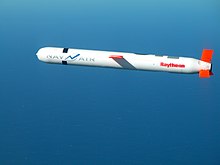
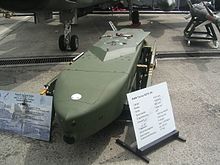
A cruise missile is a guided missile used against terrestrial targets that remains in the atmosphere and flies the major portion of its flight path at approximately constant speed. Cruise missiles are designed to deliver a large warhead over long distances with high accuracy, that is, small circular error probability. Modern cruise missiles are capable of travelling at supersonic or high subsonic speeds, are self-navigating, and are able to fly on a non-ballistic, extremely low-altitude trajectory. They are distinct from unmanned aerial vehicles (UAV) in several ways: the cruise missile is a single use weapon which is always sacrificed in the mission; it is not intended to provide aerial reconnaissance; and the warhead is integrated directly into the hull of the vehicle and cannot be separated.[citation needed]
The first cruise missiles to be deployed were the Nazi German V-1 flying bomb of World War II. Advances in transistor and computer technology have contributed to self-correcting avionic and aeronautical designs that allow missiles to be guided in flight, as opposed to only at launch. These advances developed into guided missiles and guided bombs, and later into the modern cruise missile.[citation needed]
History

The idea of an "aerial torpedo" was shown in the British 1909 film The Airship Destroyer, where flying torpedoes controlled wirelessly are used to bring down airships bombing London.[1]
In 1916, Lawrence Sperry built and patented an "aerial torpedo", a small biplane carrying a TNT charge, a Sperry autopilot and a barometric altitude control. Inspired by these experiments, the United States Army developed a similar flying bomb called the Kettering Bug. Germany had also flown trials with remote-controlled aerial gliders (Torpedogleiter) built by Siemens-Schuckert beginning in 1916.[2]
In the period between the World Wars the United Kingdom developed the Larynx (Long Range Gun with Lynx Engine), which underwent a few flight tests in the 1920s.[3]
In the Soviet Union, Sergei Korolev headed the GIRD-06 cruise missile project from 1932 to 1939, which used a rocket-powered boost-glide bomb design. The 06/III (RP-216) and 06/IV (RP-212) contained gyroscopic guidance systems.[4] The vehicle was designed to boost to 28 km altitude and glide a distance of 280 km, but test flights in 1934 and 1936 only reached an altitude of 500 meters.
Germany first deployed cruise style missiles, during World War II. The V-1, often called a flying bomb, contained a gyroscope guidance system and was propelled by a simple pulsejet engine, the sound of which gave it the nickname of "buzz bomb" or "doodlebug". Accuracy was sufficient only for use against very large targets (the general area of a city), while the range of 250 km was significantly lower than that of a bomber carrying the same payload. The main advantages were speed (while not sufficient to outperform contemporary interceptors) and expendability. The production cost of a V-1 was only a small fraction of that of a V-2 supersonic ballistic missile, carrying a similar-sized warhead. Unlike the V-2, however, the initial deployments of the V-1 required stationary launch ramps which were susceptible to bombardment. Nazi Germany, in 1943, also developed the Mistel composite aircraft program, which can be seen as a rudimentary air-launched cruise missile, where a piloted fighter-type aircraft was mounted atop an unpiloted bomber-sized aircraft that was packed with explosives to be released while approaching the target. Bomber-launched variants of the V-1 saw limited operational service near the end of the war.
Immediately after the war the United States Air Force had 21 different guided missile projects, including would-be cruise missiles. All were cancelled by 1948, except four — the Air Materiel Command BANSHEE, the SM-62 Snark, the SM-64 Navaho, and the MGM-1 Matador. The BANSHEE design was similar to Operation Aphrodite; like Aphrodite, it failed, and was canceled in April 1949.[5]
During the Cold War period both the United States and the Soviet Union experimented further with the concept, deploying early cruise missiles from land, submarines and aircraft. The main outcome of the United States Navy submarine missile project was the SSM-N-8 Regulus missile, based upon the V-1.
The United States Air Force's first operational surface-to-surface missile was the winged, mobile, nuclear-capable MGM-1 Matador, also similar in concept to the V-1. Deployment overseas began in 1954, first to West Germany and later to the Republic of China (Taiwan) and South Korea. On November 7, 1956, U.S. Air Force Matador units in West Germany, whose missiles were capable of striking targets in the Warsaw Pact, deployed from their fixed day-to-day sites to unannounced dispersed launch locations. This alert was in response to the crisis posed by the Soviet attack on Hungary which suppressed the Hungarian Revolution of 1956.
Between 1957 and 1961 the United States followed an ambitious and well-funded program to develop a nuclear-powered cruise missile, Supersonic Low Altitude Missile (SLAM). It was designed to fly below the enemy's radar at speeds above Mach 3 and carry a number of hydrogen bombs that it would drop along its path over enemy territory. Although the concept was proven sound and the 500 megawatt engine finished a successful test run in 1961, no airworthy device was ever completed. The project was finally abandoned in favor of ICBM development.
While ballistic missiles were the preferred weapons for land targets, heavy nuclear and conventional weapon tipped cruise missiles were seen by the USSR as a primary weapon to destroy United States naval carrier battle groups. Large submarines (for example, Echo and Oscar classes) were developed to carry these weapons and shadow United States battle groups at sea, and large bombers (for example, Backfire, Bear, and Blackjack models) were equipped with the weapons in their air-launched cruise missile (ALCM) configuration.
General design
Cruise missiles generally consist of a guidance system, payload, and aircraft propulsion system, housed in an airframe with small wings and empennage for flight control. Payloads usually consist of a conventional warhead or a nuclear warhead. Cruise missiles tend to be propelled by a jet engine, turbofan engines being preferred due to their greater efficiency at low altitude and subsonic speed.
Guidance systems
Guidance systems also vary greatly. Low-cost systems use a radar altimeter, barometric altimeter and clock to navigate a digital strip map. More advanced systems use inertial guidance, satellite guidance and terrain contour matching (TERCOM). Use of an automatic target recognition (ATR) algorithm/device in the guidance system increases accuracy of the missile. The Standoff Land Attack Missile features an ATR unit from General Electric.
Categories
Cruise missiles can be categorized by size, speed (subsonic or supersonic), and range, and whether launched from land, air, surface ship, or submarine. Often versions of the same missile are produced for different launch platforms; sometimes air- and submarine-launched versions are a little lighter and smaller than land- and ship-launched versions.
Guidance systems can vary across missiles. Some missiles can be fitted with any of a variety of navigation systems (Inertial navigation, TERCOM, or satellite navigation). Larger cruise missiles can carry either a conventional or a nuclear warhead, while smaller ones carry only conventional warheads.
Hypersonic
A Hypersonic speed cruise missile would travel at least five times the speed of sound (Mach 5).
- BrahMos-II
 /
/ is a hypersonic missile currently under development in India and Russia.[6]
is a hypersonic missile currently under development in India and Russia.[6] - Shaurya (missile)
 hybrid propulsion missile, with characteristics of both cruise and ballistic missile.[7][8]
hybrid propulsion missile, with characteristics of both cruise and ballistic missile.[7][8] - The planned High Speed Strike Weapon
 would be a hypersonic cruise missile.
would be a hypersonic cruise missile.
Supersonic

These missiles travel faster than the speed of sound, usually using ramjet engines. The range is typically 100–500 km, but can be greater. Guidance systems vary.
Examples:
- 3M-54 Klub
 Russia (the "Sizzler" variant is capable of supersonic speed)
Russia (the "Sizzler" variant is capable of supersonic speed) - AGM-69 SRAM
 United States
United States - Air-Sol Moyenne Portée
 France — supersonic stand-off nuclear missile
France — supersonic stand-off nuclear missile - BrahMos
 /
/ India / Russia - fastest supersonic cruise missile[9]
India / Russia - fastest supersonic cruise missile[9] - C-101
 China
China - C-301
 China
China - C-803
 China — supersonic terminal stage only
China — supersonic terminal stage only - C-805
 China
China - CJ-10
 China
China - CVS401 Perseus
 /
/ United Kingdom / France (Under development) — stealth supersonic cruise missile[10][11][12][13][14]
United Kingdom / France (Under development) — stealth supersonic cruise missile[10][11][12][13][14] - KD-88
 China
China - Kh-31
 Russia
Russia - P-270 Moskit
 /
/ USSR / Russia
USSR / Russia - P-500 Bazalt
 /
/ USSR / Russia
USSR / Russia - P-700 Granit
 /
/ USSR / Russia
USSR / Russia - P-800 Oniks
 /
/ USSR / Russia
USSR / Russia - YJ-12
 China
China - YJ-91
 China
China - Yun Feng
 Taiwan
Taiwan
Intercontinental-range
- SM-62 Snark
 United States
United States - SM-64 Navaho
 United States
United States - RSS-40 Buran
 USSR
USSR - Burya
 USSR
USSR
Long-range subsonic
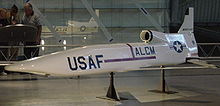
The United States, Russia, United Kingdom, Israel, South Korea, Turkey, Greece, Iran, China and India have developed several long-range subsonic cruise missiles. These missiles have a range of over 1,000 kilometres (620 mi) and fly at about 800 kilometres per hour (500 mph).[citation needed] They typically have a launch weight of about 1,500 kilograms (3,300 lb)[citation needed] and can carry either a conventional or a nuclear warhead. Earlier versions of these missiles used inertial navigation; later versions use much more accurate TERCOM and DSMAC systems. Most recent versions can use satellite navigation.
Examples:
- 3M14
 Russia
Russia - AGM-86B
 United States
United States - AGM-129 ACM
 United States
United States - BGM-109 Tomahawk
 /
/ United States/United Kingdom
United States/United Kingdom - DH-10
 China
China - HSC-1 Makedon
 Greece (1000 + km, under development)
Greece (1000 + km, under development) - Hyunmoo III
 South Korea (Hyunmoo IIIA 500 km, Hyunmoo IIIB 1000 km, Hyunmoo IIIC 1500 km)
South Korea (Hyunmoo IIIA 500 km, Hyunmoo IIIB 1000 km, Hyunmoo IIIC 1500 km) - Kh-101
 Russia
Russia - Meshkat
 Iran (Range 2000 km)[15]
Iran (Range 2000 km)[15] - Nirbhay
 India (1000 + km)
India (1000 + km) - Popeye Turbo SLCM
 Israel
Israel - RK-55
 Soviet Union
Soviet Union - SOM (missile) (SOM B Block I)
 Turkey (350 km range under serial production, 500 km + range under development) - 500 km, 1500 km and 2500 km versions [16][17][18]
Turkey (350 km range under serial production, 500 km + range under development) - 500 km, 1500 km and 2500 km versions [16][17][18]
Medium-range subsonic

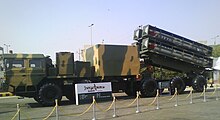
These missiles are about the same size and weight and fly at similar speeds to the above category, but the range is (officially)[citation needed] less than 1,000 km. Guidance systems vary.
Examples:
- Apache

- AGM-158 JASSM
 United States
United States - Babur
 Pakistan
Pakistan - KD-63
 China
China - Popeye turbo ALCM
 Israel
Israel - Ra'ad ALCM
 Pakistan
Pakistan - Raad
 Iran
Iran - Storm Shadow/SCALP
 /
/ /
/ UK / France / Italy
UK / France / Italy - Taurus KEPD 350
 /
/ /
/ Germany / Sweden / Spain
Germany / Sweden / Spain
Short-range subsonic
These are subsonic missiles which weigh around 500 kilograms (1,102 lb) and have a range of up to 300 km (190 mi).[citation needed]

Examples:
- AVMT-300
 Brazil
Brazil - C-801
 China
China - C-802
 China
China - C-602
 China
China - Delilah missile
 Israel
Israel - Gabriel IV
 Israel
Israel - Hae Sung
 Korea
Korea - Kh-35
 Russia
Russia - P-15 KN-1
 Russia
Russia - Silkworm KN-1
 China
China - Nasr-1
 Iran
Iran - Naval Strike Missile
 Norway
Norway - Zarb
 Pakistan
Pakistan - Noor
 Iran
Iran - Qader
 Iran
Iran - RBS-15
 Sweden
Sweden - RGM-84 Harpoon
 United States
United States - Silkworm
 China
China - SOM (missile)
 Turkey[19][20]
Turkey[19][20] - Zafar
 Iran
Iran
Deployment

The most common mission for cruise missiles is to attack relatively high-value targets such as ships, command bunkers, bridges and dams.[citation needed] Modern guidance systems permit precise attacks.
(As of 2001) the BGM-109 Tomahawk missile model has become a significant part of the United States naval arsenal. It gives ships and submarines an extremely accurate, long-range, conventional land attack weapon. Each costs about US$830,000.[21] Both the Tomahawk and the AGM-86 were used extensively during Operation Desert Storm.
The United States Air Force (USAF) deploys an air-launched cruise missile, the AGM-86 ALCM. The B-52 Stratofortress is the exclusive delivery vehicle for the AGM-86 and AGM-129 ACM. Both missile types are configurable for either conventional or nuclear warheads.
Both Tomahawk (as BGM-109) and ALCM (AGM-86) were competing designs for the USAF. ALCM nuclear tipped cruise missile to be carried by the B-52 heavy bomber. [citation needed]
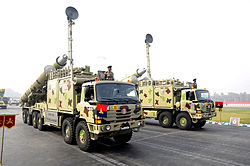
The USAF adopted the AGM-86 for its bomber fleet while AGM-109 was adapted to launch from trucks and ships and adopted by the USAF and Navy. The truck-launched versions, and also the Pershing II and SS-20 Intermediate Range Ballistic Missiles, were later destroyed under the bilateral INF (Intermediate Range Nuclear Forces) treaty with the USSR.
The British Royal Navy (RN) also operates cruise missiles, specifically the U.S.-made Tomahawk, used by the RN's nuclear submarine fleet. UK conventional warhead versions were first fired in combat by the RN in 1999, during the Kosovo War (the United States fired cruise missiles in 1991). The Royal Air Force uses the Storm Shadow cruise missile on its Tornado GR4 aircraft. It is also used by France, where it is known as SCALP EG, and carried by the Armée de l'Air's Mirage 2000 and Rafale aircraft.
India and Russia have jointly developed the supersonic cruise missile BrahMos. There are three versions of the Brahmos: ship/land-launched, air-launched and sub-launched. The ship/land-launched version were operational as of late 2007. The Brahmos has the capability to attack targets on land. Russia also continues to operate other cruise missiles: the SS-N-12 Sandbox, SS-N-19 Shipwreck, SS-N-22 Sunburn and SS-N-25 Switchblade. Germany and Spain operate the Taurus missile while Pakistan has developed its own cruise missile somewhat similar to Tomahawk cruise missile, named the Babur missile. Both the People's Republic of China and the Republic of China (Taiwan) have designed several cruise missile variants, such as the well-known C-802, some of which are capable of carrying biological, chemical, nuclear, and conventional warheads.
Nuclear warhead versions
France
The French Force de Frappe nuclear forces include both land and sea based bombers with Air-Sol Moyenne Portée high speed medium range nuclear cruise missiles. Two models are in use, ASMP and a newer ASMP-A. Approximately 60 nuclear missiles are in service, 50 land based and 10 sea based. [citation needed]
India
In 2014, India successfully tested nuclear-capable long-range subsonic cruise missile Nirbhay.[22] The missile was developed by India's Aeronautical Development Establishment (ADE), has a range of more than 1,000 km (620 mi) and is expected to enter mass-production for the Indian Armed Forces by 2016.[23]
Israel
The Israeli Defense Forces reportedly deploy the medium-range air-launched Popeye Turbo ALCM and the Popeye Turbo SLCM medium-long range cruise missile with nuclear warheads on Dolphin class submarines. [citation needed]
Pakistan
Pakistan currently has three cruise missile systems in service, of which, two are nuclear-capable cruise missiles: the air-launched Ra'ad and the ground-launched Babur, and the sea-launched Zarb.[24][25] Both, Ra'ad and Babur, can carry nuclear warheads between 10 and 35 kt, and deliver them to targets at a range of 350 km (220 mi) and 700 km (430 mi) respectively. Ra'ad is in the use of Pakistan Air Force since 2007, while Babur is with the Pakistan Army since 2005.[26] The Zarb, though not nuclear nor any information is officially submitted by the Pakistani military reports, joined the service with Pakistan Navy in 2016.
Russia
Russia has Kh-55SM cruise missiles, with similar to United States' AGM-129 range of 3000 km, but are able to carry more powerful warhead of 200 kt. They are equipped with a TERCOM system which allows them to cruise at an altitude lower than 110 meters at subsonic speeds while obtaining a CEP accuracy of 15 meters with an Inertial navigation system. They are air-launched from either Tupolev Tu-95s, Tupolev Tu-22Ms, or Tupolev Tu-160s, each able to carry 16 for the Tu-95, 12 for the Tu-160, and 4 for the Tu-22M. A stealth version of the missile, the Kh-101 is in development. It has similar qualities as the Kh-55, except that its range has been extended to 5,000 km, equipped with a 1,000 kg conventional warhead, and has stealth features which reduces its probability of intercept.[27]
United States
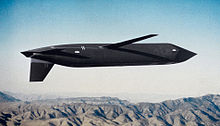
The United States has deployed four nuclear cruise missiles at one time or another.
- SSM-N-8 Regulus submarine-launched missile, out of service
- AGM-86 ALCM air-launched cruise missile, 350 to 550 missiles and W80 warheads still in service
- BGM-109 Tomahawk cruise missile in nuclear submarine-, surface ship-, and ground-launched models, nuclear models out of service but warheads kept in reserve.
- AGM-129 ACM Advanced Cruise missile, out of service [28]
Efficiency in modern warfare
Currently cruise missiles are among the most expensive of single-use weapons, up to several million dollars apiece. One consequence of this is that its users face difficult choices in target allocation, to avoid expending the missiles on targets of low value. For instance during Operation Enduring Freedom the United States attacked targets of very low monetary value with cruise missiles, which led many to question the efficiency of the weapon. However, proponents of the cruise missile counter that the same argument applies to other types of UAVs: they are cheaper than human pilots when total training and infrastructure costs are taken into account, not to mention the risk of loss of personnel. As demonstrated in Operation Odyssey Dawn and prior conflicts, cruise missiles are much more difficult to detect and intercept than other aerial assets (reduced radar cross-section, infrared and visual signature due to smaller size), suiting them to attacks against static air defense systems.
See also
- Affordable Weapon System
- Cruise missile submarine
- Eugene Vielle (pioneer of technology that led to the Cruise missile)
- Expendable launch system
- Intercontinental ballistic missile
- List of missiles
- List of missiles by country
- List of rocket aircraft
- Lists of weapons
- Low Cost Miniature Cruise Missile
- NATO reporting name (has lists of various Soviet missiles)
- Submarine-launched cruise missile
- Surface-to-surface missile
- Weapon of mass destruction
References
- ^ "Remote Piloted Aerial Vehicles : The 'Aerial Target' and 'Aerial Torpedo' in Britain". Ctie.monash.edu.au. Retrieved 2012-02-13.
- ^ Roger Branfill-Cook, "Torpedo", Seaforth Publishing, Great Britain 2014
- ^ British Aerial Torpedoes
- ^ "Object No. 212", 1936 report in _Tvorcheskoi Nasledie Akedemika Sergeya Pavlovicha Koroleva_
- ^ The Evolution of the Cruise Missile by Werrell, Kenneth P. see PDF page 92 Archived 2007-03-04 at the Wayback Machine
- ^ "Hypersonic version of Brahmos on the way". The Times Of India. October 9, 2011.
- ^ Shaurya surfaces as India's underwater nuclear missile - 1 - National News – News – MSN India
- ^ "Shaurya surfaces as India's underwater nuclear missile". Business Standard News.
- ^ "Supersonic Stealth Missile". Retrieved 8 October 2015.
- ^ Janes - Perseus: MBDA's missile of the future?
- ^ "International Institute for Strategic Studies - IISS". Retrieved 8 October 2015.
- ^ "New British missile three times as fast as current weapons". Telegraph.co.uk. 21 June 2011. Retrieved 8 October 2015.
- ^ MBDA Systems
- ^ "PARIS: Perseus set to go on the attack". Flightglobal.com. Retrieved 8 October 2015.
- ^ Administrator. "Iran will unveil its new home-made cruise missile Meshkat in the near future 0909128 - September 2012 new army military defence industry - Military army defense industry news year 2012". Retrieved 8 October 2015.
- ^ Ümit Enginsoy. "BUSINESS - Turkey aims to increase ballistic missile ranges". Hurriyetdailynews.com. Retrieved 2012-02-13.
- ^ "TÜBİTAK: Hedefimiz 2 bin 500 kilometre menzilli füze yapmak - Hürriyet EKONOMİ". Hurriyet.com.tr. 2012-01-14. Retrieved 2012-02-13.
- ^ "Türk Füzesi SOM İçin Geri Sayım Başladı - Haber - TRT Avaz". Trt.net.tr. Retrieved 2012-02-13.
- ^ "Yerli seyir füzesi, 180 kilometreden hedefini vuracak - Hürriyet Gündem". Hurriyet.com.tr. Retrieved 2012-02-13.
- ^ "Yerli seyir füzesi, 180 kilometreden hedefinin vuracak - Kirpi HABER Cesur | Özgür | Tarafsız Habercilik". Kirpihaber.com. Retrieved 2012-02-13.
- ^ http://www.bbc.co.uk/news/uk-12806709 According to Prof Malcolm Charmers of defence think-tank the Royal United Services Institute
- ^ "Meet India's New Nuclear Cruise Missile". The Diplomat. October 18, 2014.
- ^ "Successful test for India's Nirbhay cruise missile". Space Daily. Oct 21, 2014.
- ^ "Hatf 8". Missilethreat.com. Retrieved 20 January 2016.
- ^ "Hatf 7". Missilethreat.com. Retrieved 20 January 2016.
- ^ Mason, Shane. "Pakistan's Babur and Ra'ad Cruise Missiles: Strategic Implications for India". Institute of Peace and Conflic Studies. Retrieved 20 January 2016.
- ^ "Kh-101 - Russian and Soviet Nuclear Forces". Fas.org. Retrieved 2012-02-13.
- ^ "Cruise missile career comes to a close". U.S. Air Force, Tinker Air Force Base public affairs. 2012-04-24. Retrieved 2012-12-27.
External links
- The Evolution of the Cruise Missile by Werrell, Kenneth P.
- The Cruise Missile: Precursors and Problems by Werrell, Kenneth P.
- An introduction to cruise missiles — From the website of the Federation of American Scientists (FAS)
- Feasibility of Third World Advanced Ballistic & Cruise Missile Threat NDIA 155 slide presentation from 1999
- The DIY cruise missile
- The W80 Warhead
- Cruise Missile Fundamentals
- Tomahawk Variants
- Bypassing the NMD: China and the Cruise Missile Proliferation Problem (Kh-55)
- Video of cruise missile formation over Iraq
- A commercial terrain matching image-based navigation system (with video)
